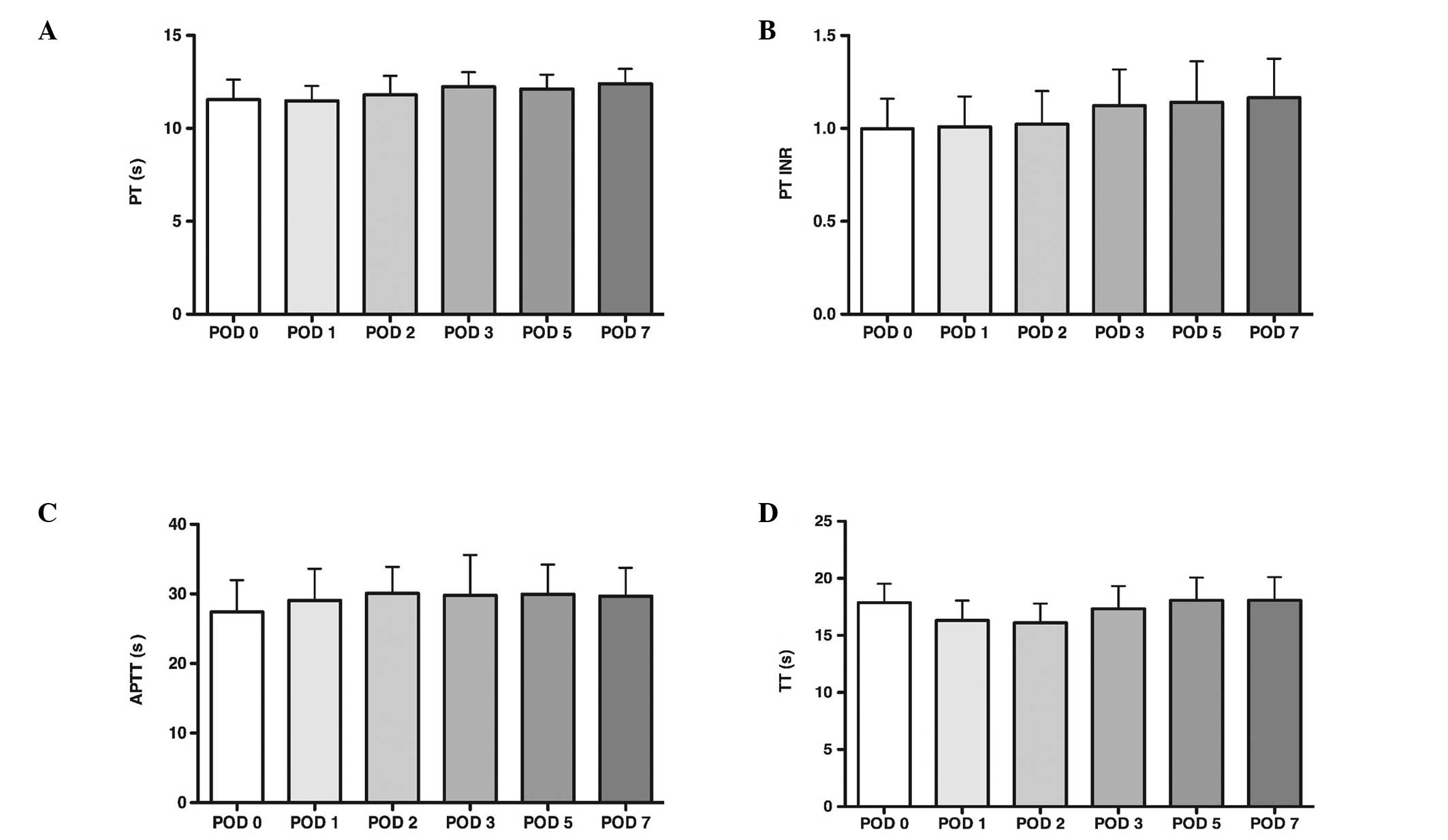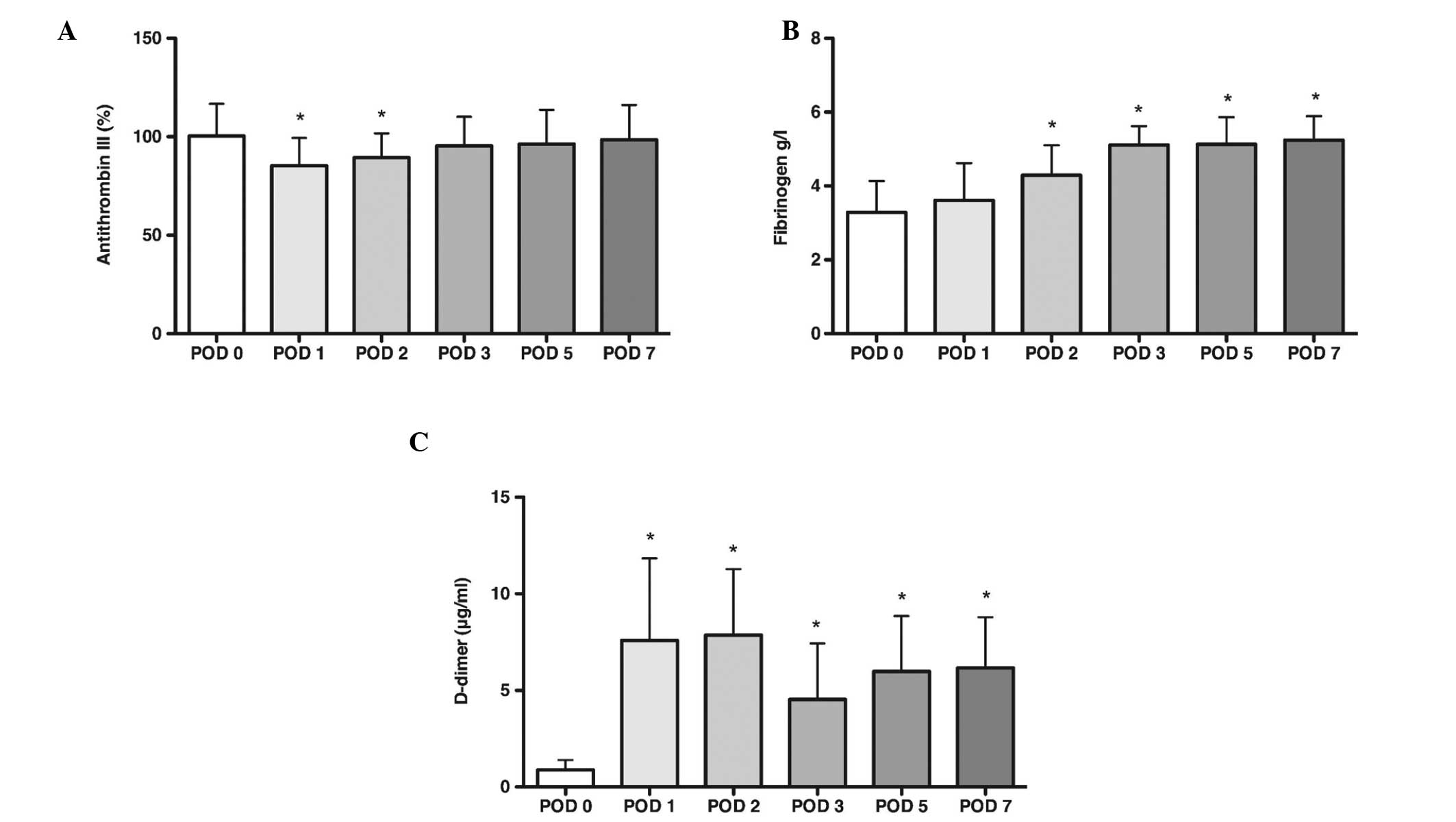|
1
|
Anderson JA, Lim W and Weitz JI: Genetics
of coagulation: what the cardiologist needs to know. Can J Cardiol.
29:75–88. 2013. View Article : Google Scholar
|
|
2
|
Fisher WD: Impact of venous
thromboembolism on clinical management and therapy after hip and
knee arthroplasty. Can J Surg. 54:344–351. 2011. View Article : Google Scholar : PubMed/NCBI
|
|
3
|
Falck-Ytter Y, Francis CW, Johanson NA, et
al; American College of Chest Physicians. Prevention of VTE in
orthopedic surgery patients: Antithrombotic Therapy and Prevention
of Thrombosis, 9th ed: American College of Chest Physicians
Evidence-Based Clinical Practice Guidelines. Chest. 141(2 Suppl):
e278S–e325S. 2012. View Article : Google Scholar : PubMed/NCBI
|
|
4
|
Barrack RL: Current guidelines for total
joint VTE prophylaxis: dawn of a new day. J Bone Joint Surg Br.
94:3–7. 2012. View Article : Google Scholar : PubMed/NCBI
|
|
5
|
Sadler JE: von Willebrand factor: two
sides of a coin. J Thromb Haemost. 3:1702–1709. 2005. View Article : Google Scholar : PubMed/NCBI
|
|
6
|
Zheng X, Chung D, Takayama TK, Majerus EM,
Sadler JE and Fujikawa K: Structure of von Willebrand
factor-cleaving protease (ADAMTS13), a metalloprotease involved in
thrombotic thrombocytopenic purpura. J Biol Chem. 276:41059–41063.
2001. View Article : Google Scholar : PubMed/NCBI
|
|
7
|
Porter S, Clark IM, Kevorkian L and
Edwards DR: The ADAMTS metalloproteinases. Biochem J. 386:15–27.
2005. View Article : Google Scholar :
|
|
8
|
Tsai HM: Physiologic cleavage of von
Willebrand factor by a plasma protease is dependent on its
conformation and requires calcium ion. Blood. 87:4235–4244.
1996.PubMed/NCBI
|
|
9
|
Furlan M, Robles R and Lämmle B: Partial
purification and characterization of a protease from human plasma
cleaving von Willebrand factor to fragments produced by in vivo
proteolysis. Blood. 87:4223–4234. 1996.PubMed/NCBI
|
|
10
|
Fujikawa K, Suzuki H, McMullen B and Chung
D: Purification of human von Willebrand factor-cleaving protease
and its identification as a new member of the metalloproteinase
family. Blood. 98:1662–1666. 2001. View Article : Google Scholar : PubMed/NCBI
|
|
11
|
Koster T, Blann AD, Briet E, Vandenbroucke
JP and Rosendaal FR: Role of clotting factor VIII in effect of von
Willebrand factor on occurrence of deep-vein thrombosis. Lancet.
345:152–155. 1995. View Article : Google Scholar : PubMed/NCBI
|
|
12
|
Tsai AW, Cushman M, Rosamond WD, et al:
Coagulation factors, inflammation markers, and venous
thromboembolism: the longitudinal investigation of thromboembolism
etiology (LITE). Am J Med. 113:636–642. 2002. View Article : Google Scholar : PubMed/NCBI
|
|
13
|
Wang AY, Liu F, Ma ZN, Dong NZ, Zhang JY
and Ruan CG: Research on the C-terminal domain of ADAMTS13
regulates its cleaving activity. Zhonghua Xue Ye Xue Za Zhi.
31:830–834. 2010.(In Chinese).
|
|
14
|
Kokame K, Nobe Y, Kokubo Y, Okayama A and
Miyata T: FRETS-VWF73, a first fluorogenic substrate for ADAMTS13
assay. Br J Haematol. 129:93–100. 2005. View Article : Google Scholar : PubMed/NCBI
|
|
15
|
Ruan CG, Xi XD and Gu JM: Studies on
monoclonal antibodies to human von Willebrand factor. Zhonghua Nei
Ke Za Zhi. 25:547–550. 1986.(In Chinese).
|
|
16
|
Zhao Y, Gu Y, Ji S, Yang J, Yu Z and Ruan
C: Development of an ELISA method for testing VWF ristocetin
cofactor activity with improved sensitivity and reliability in the
diagnosis of von Willebrand disease. Eur J Haematol. 88:439–445.
2012. View Article : Google Scholar : PubMed/NCBI
|
|
17
|
Clarke MT, Green JS, Harper WM and Gregg
PJ: Screening for deep-venous thrombosis after hip and knee
replacement without prophylaxis. J Bone Joint Surg Br. 79:787–791.
1997. View Article : Google Scholar : PubMed/NCBI
|
|
18
|
Piovella F, Wang CJ, Lu H, et al:
Deep-vein thrombosis rates after major orthopedic surgery in Asia.
An epidemiological study based on postoperative screening with
centrally adjudicated bilateral venography. J Thromb Haemost.
3:2664–2670. 2005. View Article : Google Scholar : PubMed/NCBI
|
|
19
|
Spirin VA, Khomenko NM and Vasil’kov VG:
Hemostasis system in patients with bile duct diseases undergoing
surgery under peridural anesthesia and neuroleptanalgesia.
Anesteziol Reanimatol. 55–57. 1982.(In Russian).
|
|
20
|
Bergqvist D: Assessment of the risk and
the prophylaxis of venous thromboembolism in surgical patients.
Pathophysiol Haemost Thromb. 33:358–361. 2003. View Article : Google Scholar
|
|
21
|
Müller R and Musikić P: Hemorheology in
surgery - a review. Angiology. 38:581–592. 1987. View Article : Google Scholar
|
|
22
|
Picker SM: In-vitro assessment of platelet
function. Transfus Apher Sci. 44:305–319. 2011. View Article : Google Scholar : PubMed/NCBI
|
|
23
|
Lindberg F, Rasmussen I, Siegbahn A and
Bergqvist D: Coagulation activation after laparoscopic
cholecystectomy in spite of thromboembolism prophylaxis. Surg
Endosc. 14:858–861. 2000. View Article : Google Scholar : PubMed/NCBI
|
|
24
|
El Kady N, Khedr H, Yosry M and El Mekawi
S: Perioperative assessment of coagulation in paediatric
neurosurgical patients using thromboelastography. Eur J
Anaesthesiol. 26:293–297. 2009. View Article : Google Scholar : PubMed/NCBI
|
|
25
|
Schietroma M, Carlei F, Mownah A, et al:
Changes in the blood coagulation, fibrinolysis, and cytokine
profile during laparoscopic and open cholecystectomy. Surg Endosc.
18:1090–1096. 2004.PubMed/NCBI
|
|
26
|
Goobie SM, Soriano SG, Zurakowski D,
McGowan FX and Rockoff MA: Hemostatic changes in pediatric
neurosurgical patients as evaluated by thrombelastograph. Anesth
Analg. 93:887–892. 2001. View Article : Google Scholar : PubMed/NCBI
|
|
27
|
Lison S, Weiss G, Spannagl M and Heindl B:
Postoperative changes in procoagulant factors after major surgery.
Blood Coagul Fibrinolysis. 22:190–196. 2011. View Article : Google Scholar : PubMed/NCBI
|
|
28
|
Sadler JE: von Willebrand factor assembly
and secretion. J Thromb Haemost. 7(Suppl 1): 24–27. 2009.
View Article : Google Scholar : PubMed/NCBI
|
|
29
|
Geerts WH, Pineo GF, Heit JA, et al:
Prevention of venous thromboembolism: the Seventh ACCP conference
on antithrombotic and thrombolytic therapy. Chest. 126:338S–400S.
2004. View Article : Google Scholar : PubMed/NCBI
|
|
30
|
Zhao YM, Jiang M, Ji SD, et al: Anti-human
VWF monoclonal antibody SZ-123 prevents arterial thrombus formation
by inhibiting VWF-collagen and VWF-platelet interactions in Rhesus
monkeys. Biochem Pharmacol. 85:945–953. 2013. View Article : Google Scholar : PubMed/NCBI
|












